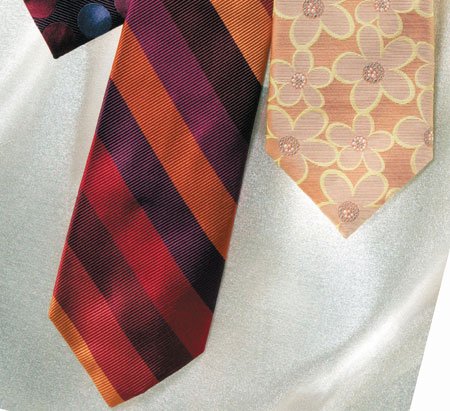The necktie is so tangled up in Father’s Day it’s become the
cliche gift of the century.
Edward M. Eveld – McClatchy Newspapers
The necktie is so tangled up in Father’s Day it’s become the cliche gift of the century.
Or maybe it’s the perfect gift. Fine line.
On the cliche side, the choice of a tie for Dad is lame, the tie, unwanted.
But the “not another tie” message resonated more soundly just a few years ago, before suit coats and ties started clawing their way back from “business casual.”
“People are dressing up more today,” said Keith Novorr, owner of Michael’s Fine Clothes for Men in Kansas City, Mo. “It’s reverting back.”
As for the tie being an uninspired gift, Novorr doesn’t think so. It would be much easier to choose khakis and a sport shirt for most men. Customers often ask, “Can you pick out a tie my father would like?” Novorr tells them he can, but first he has to learn something about him.
“Ties are extremely personal,” Novorr said. “You can almost tell the personality of a person by his neckwear.”
Lee Allison, who has a nationally recognized tie-selling Web site (www.leeallison.com), said there’s always been a lot to recommend a tie gift.
“A tie rejuvenates an entire outfit, so it’s the biggest bang for the buck,” Allison said. “The rest of the outfit is the frame, and the tie is the piece of art. It’s the exclamation point.”
And, in fact, the tie remains the leading Father’s Day gift, according to the U.S. Census Bureau. Americans buy 100 million ties a year.
So how did the necktie become intertwined with Father’s Day? Father’s Day emerged after World War I and was followed in the 1920s by the creation of the modern tie, constructed from three pieces of fabric, cut on the bias, with a lining. Tie makers and sellers saw the potential and began pushing neckties as gifts, said Jerry Andersen, executive director of the Men’s Dress Furnishings Association in New York.
Now, as then, ties are an affordable gift. Buying the right size isn’t a problem, and they’re in fashion again.
“A lot of people are just getting back into neckties, particularly younger men,” Andersen said.
The deeper question – why wear anything around the neck at all? – takes us way back in time. Neck coverings were needed for protection against the elements but quickly morphed into a fashion statement, from demonstrating social status to expressing individuality.
As our timeline shows, neckwear’s history is long and storied, but its genealogy can be stated fairly simply: Knotted scarves begat the cravat or neckcloth, and the cravat begat the modern tie, knotted carefully at the neck with the blade falling cleanly to the belt.
The Windsor Knot
For standard shirt collars
1. Start with wide end of the tie on your right and
extending a foot below narrow end.
2. Cross wide end over narrow and bring up through loop.
3. Bring wide end down around behind narrow and up on your right.
4. Then put down through loop and around across narrow as shown.
5. Turn and pass up through loop and …
6. Complete by slipping down through the knot in front. Tighten and draw up snug to collar.
The Four-in hand knot
Long and straight – to complement a standard shirt collar
1. Start with wide end of the tie on your right and extending a foot below narrow end.
2. Cross wide end over narrow and turn back underneath.
3. Continue around passing wide end across front of narrow once more.
4. Pass side end up through loop.
5. Holding front of knot loose with index finger, pass wide end down through loop in front.
6. Remove finger and tighten knot carefully. Draw up tight to collar by holding narrow end and sliding knot snug.
The half-windsor knot
1. Start with wide end of the tie on your right and extending a foot below narrow end.
2. Cross wide end over narrow and turn back underneath.
3. Bring up and turn down through loop.
4. Pass wide end around front from left to right.
5. Then up through loop …
6. And down through knot in front. Tighten carefully and draw up to collar.















